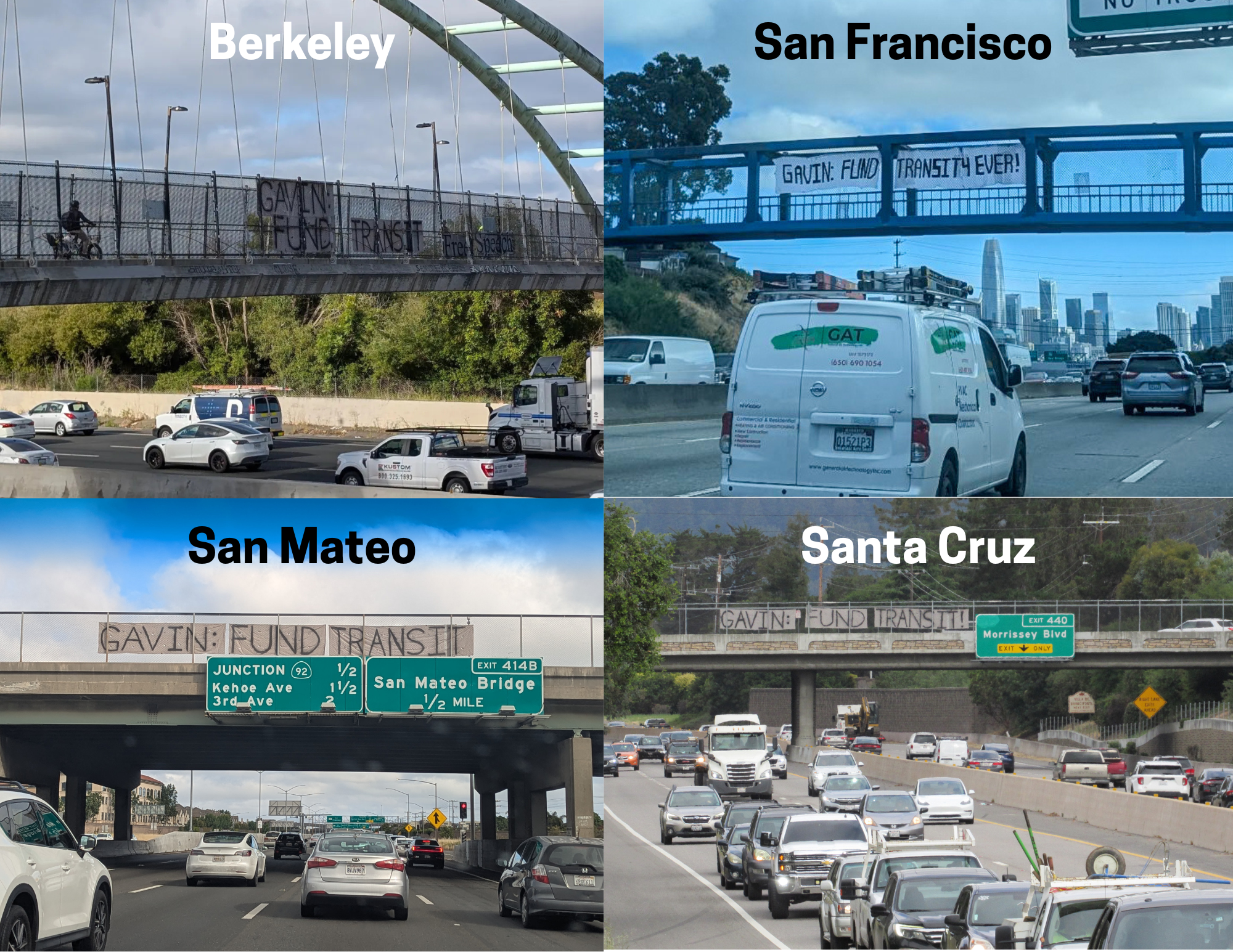Governor’s “May Revise” budget proposal cuts public transit; up to legislature to push back
Disappointing budget news for transit riders came on Wednesday, May 14 when Governor Newsom announced his regularly scheduled May update to his budget proposal, commonly called the “May Revise”. Anticipating a $12B deficit in a $321B budget, the governor’s proposal slashes funds for transportation service and capital, among other cuts to key programs that fund housing adjacent to transit.
The state budget must be negotiated between the governor and the legislature, and it is now in the legislature’s hands to defend and improve support for public transit and active transportation.
Read on - and sign up for a webinar on Thursday to learn more about what’s going on and how you can take action to save transit in the state budget.
“May Revise” proposes transit budget cuts
The "May Revise” transit budget cuts were announced one day after advocates in 12 cities across California unfurled freeway overpass banners urging Governor Newsom to fund public transit (Source: Streetsblog Cal).
The “May Revise” did not contain the $2B budget ask made by Senators Wiener and Arreguín, and Assemblymember Mark Gonzalez, that would provide vital funding for riders who depend upon frequent and reliable service. Even worse, the budget proposal slashes existing transit funding. The budget proposal clawed back nearly $700 million in undistributed funding that transit advocates won in 2023 to keep transit running.
And the budget proposal also slashed funding for transit from the state’s Cap-and-Trade program, which has overall been generating $4B per year for climate action. In the details of the governor’s budget proposal for the Cap-and-Trade program’s Greenhouse Gas Reduction Fund (GGRF), funding is slashed for programs that are essential to keeping transit running:
The Low Carbon Transit Operations Program, which many agencies use to run new service and subsidize low-income and student fare discount programs.
The Transit and Intercity Rail Capital (TIRCP) program, a major source of support for rail and transit projects around the state.
The Affordable Housing and Sustainable Communities program which provides funding for affordable homes near transit and transit improvements to support those homes.
Michael Pimentel, the Executive Director of the California Transit Association which lobbies for transit agencies, has a rundown on the dismaying proposal in this Bluesky thread.
Also bad news for active transportation
Not only that, the governor’s proposal provides scraps for active transportation, at a time when the federal government is defunding pedestrian and bike safety. The governor’s proposal offers $200 million for the state’s active transportation program. According to Streetsblog, the state’s Active Transportation program received $2.5 billion in requests last year, with only 12 out of hundreds of projects statewide funded. Projects that scored 95 out of 100 in the state’s scoring metric were not funded because of the lack of funds.
Silver lining for High Speed Rail
The governor’s proposal does recommend that a minimum of $1 billion in Cap-and-Trade funds be allocated for high-speed rail each year. This would provide nearly enough money to complete the initial Central Valley segment between Merced and Bakersfield. By contrast, around the world, successful high speed rail programs depend on a complementary system of intercity, regional rail, and local transportation to complement fast long-distance service
Now up to the legislature to defend rail and transit, and active transportation
This means it's time for the legislators to step up. Negotiation by the legislature with the Governor is expected and essential to bring transit funding back into the budget to save service for riders around the state. According to reports including from the Legislative Analysts Office, “representatives from the administration have indicated the Governor wants to determine future funding allocations for both discretionary and statutory GGRF-funded programs through negotiations with the Legislature.”
Legislative leaders – specifically the budget chairs on the Assembly and Senate, the Assembly Speaker, and the Senate President Pro Tempore – must negotiate a budget deal with the Governor by June 15th, or face permanently forfeiting salary due to voter-approved Proposition 25 (2010).
However, in practice, the timeline is likely to extend through the legislative session in early September, because the state’s revenue picture will change due to tax filings delayed because of the LA fires and national uncertainties. The legislature is expected to make more spending changes, through what are called “budget trailer bills” after the June 15 formal budget deadline and the end of the legislative session.
To learn more about what’s going on and how you can help, Seamless is joining Move California and allies in a webinar on Thursday, May 22nd at 12:30pm. Register here to learn more on how you can stand up to safe transit and climate progress in the state budget.

